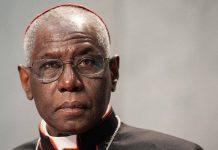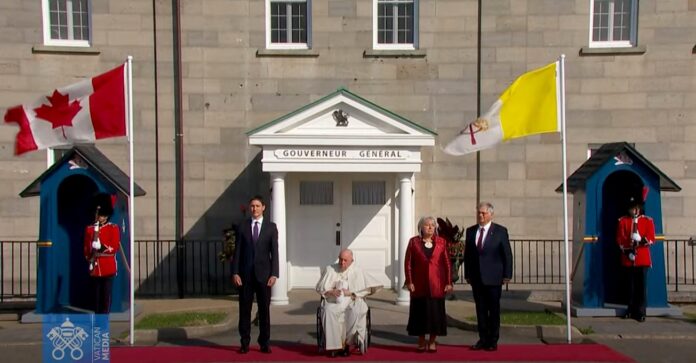After arriving in Canada on July 24, 2022 and completing the Alberta portion of his pilgrimage of healing, reconciliation, and hope, the Holy Father flew from Edmonton International Airport on an ITA Airways A330 aircraft to Quebec City to continue his penitential pilgrimage.
Newsroom (27/07/2022 8:40 PM Gaudium Press) From the Airport in Quebec city, the Pope travelled by motorcade to The Citadelle where the Governor General of Canada greeted him, her Excellency the Right Honourable Mary Simon, who is an Inuk leader from Nunavik in Quebec, and the Right Honorable Prime Minister of Canada, Justin Trudeau. This was followed by the military band first playing the Vatican National Anthem and O Canada, the Canadian National Anthem. The three were flanked on either side by the Canadian and the Vatican Flag.
At The Citadelle
The Citadelle of Quebec (French: Citadelle de Québec), also known as La Citadelle, is an active military installation and the official secondary residence of the Canadian monarch and the governor-general of Canada.
It is located atop Cap Diamant, adjoining the Plains of Abraham in Quebec City, Quebec. The citadel contains the oldest military building in Canada and forms part of the fortifications of Quebec City.
The British used the citadel until 1871 when they formally handed the property over to the Canadian government. Following the handover, the citadel was used as a military installation by the Canadian Armed Forces and as a royal and viceregal residence.
Pope Francis signed the book of honour at the Citadelle de Québec. He wrote: “As a pilgrim in Canada, a land that stretches from sea to sea, I pray to God that this great country will always be an example in building a future that preserves and values its roots, particularly its indigenous peoples, and in being a welcoming home for all.”
Within The Citadelle, the Pope had a private conversation with the Governor General over a far away. Still, with an open microphone, one could overhear the two heads of state discussing which languages they could speak. The Pope could be heard saying in English that he could speak Spanish and Italian but shook his hands, indicating that he was less fluent in French and English. The Governor General said she is learning French but is fluent in her native language because her mother and grandmother only spoke it to her. This was a very poignant moment between the two leaders with many smiles and warmth. The Pope similarly had a private conversation with Prime Minister Justin Trudeau. The Governor General and Prime minister also met with the Secretary of State of the Holy See, Cardinal Pietro Parolin.
Following the private talks, Indigenous drums and singing welcomed The Holy Father, the Governor General and the Prime Minister for the formal speeches. This was preceded by a welcome speech in French along with a native blessing by a member of the First Nations.
The first speech was by Prime Minister Trudeau (bilingual in English and French), who spoke about the sorrows of family separation at residential schools and the emotional, physical, religious and sexual abuse at the hands of the residential schools run by the Catholic Church. He also commented that the Pope’s visit and apology is a first step in the journey of reconciliation.
Governor General Mary Simon spoke next (bilingual in English and French), covering many of the same points as the Prime Minister while also bringing out the ongoing struggle and survivorship of indigenous peoples and their willingness to listen, forgive and continue to hold on to their cultural identities. She also spoke in her mother tongue and said she looked forward to the ongoing reconciliation process both within the Church and in Canada.
The previous two speeches tended to indicate that the government of Canada was first at the table when it came to reconciliation with the indigenous peoples. This, however, was corrected by Pope Francis in his speech.
Pope Francis spoke in Spanish “It is our desire to renew the relationship between the church and the Indigenous peoples of Canada, a relationship marked both by a love that has borne outstanding fruit and, tragically, deep wounds that we are committed to understanding and healing.” Read the full text here. The speeches concluded with a brother and sister duo playing the guitar and violin for the three heads of state.
The Plaines d’Abraham
Following the addresses to Canadians, the Holy Father departed the Citadelle of Québec, making his way via popemobile to the Plains of Abraham, where he made a Giro (tour) among the people gathered to rapturous clapping, singing and indigenous drumming. There were mandatory stops to bless babies as the Pope’s mobile made its way around the Plains of Abraham. After the Giro, the Holy Father travels to the residence of the Archbishop of Québec, where he will reside during his stay in the province.
The Plains of Abraham (French: Plaines d’Abraham) is a historic area within the Battlefields Park in Quebec City, Quebec, Canada. The land is the site of the Battle of the Plains of Abraham, which took place on September 13, 1759.
On September 13, 1759, the area was the scene of the Battle of the Plains of Abraham, part of the French and Indian War, which was itself part of the Seven Years’ War. On that date, British soldiers under the command of General Wolfe climbed the steep cliff under the city in darkness, surprising and defeating the French through a single deadly volley of musket fire, causing the battle to be over within 30 minutes.
The battle involved fewer than 10,000 troops in total. Both Wolfe and the French commander, the Marquis de Montcalm, died of their wounds, but the battle left control of Quebec City to the British, eventually allowing them to take control of Canada the following year. The land was originally owned by a farmer named Abraham Martin, hence the name of the battle.
Compiled by Raju Hasmukh



































